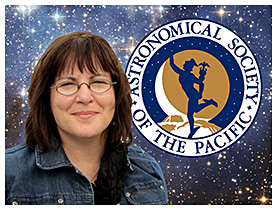News from the Astronomical Society of the Pacific
Linda Shore Astronomical Society of the Pacific
Fortunately the university was near ASP headquarters, to which I made regular visits to get help. Had it not been for the ASP’s support, teaching resources, and incredible collection of 35-mm slides, I would not have become a successful astronomy lecturer. Without this early success as a novice astronomy teacher, I would not have pursued a career in science education, never conducted research on astronomy preconceptions at the Harvard-Smithsonian Center for Astrophysics, never written a dissertation on the impact that professional development has on improving the astronomy knowledge of teachers, and never caught the attention of the Exploratorium, where I served as the director of the Teacher Institute for 20 years. Ultimately, I would not have ended up as the first woman to become executive director of the ASP ― the very organization that got me started down this road in the first place.
Never underestimate the power of the ASP to change lives.
Somewhere right now, there is a high-school student looking at the ASP’s Facebook page and “liking” the announcement of a new and unusual exoplanet. A graduate student in astronomy is reading a PASP article on active galaxies as she prepares ideas for her dissertation. An amateur astronomer is thinking about hosting a star party for an elementary school and is searching the NASA Night Sky Network website in search of astronomy activities developed by the ASP. A park ranger is using ASP materials to prepare an evening stargazing event for visitors. Literally thousands of people make use of ASP materials each year to learn astronomy or to teach it to someone else.
Now celebrating its 125th anniversary, the ASP was founded 10 years before the AAS. Our two societies collaborated throughout the 20th century and continue to work together in the 21st, most notably on the Astronomy Ambassadors program. Conceived by AAS Past-President Debra Elmegreen, it offers professional-development workshops and a community of practice to help improve early-career astronomers' ability to effectively communicate with students and the public. We are honored that the AAS saw fit to “outsource” much of the work of developing and conducting the program to the ASP. The workshops at the last two winter AAS meetings attracted 60 remarkable young astronomers from all over North America, and the outreach that they’re now doing as AAS Astronomy Ambassadors is exemplary. I look forward to working with the AAS to build on our early success in this program and to find additional ways to collaborate in our joint quest to share the wonders of the universe with a broader audience.
In the coming months I will be working with the ASP staff to expand our existing programs and develop new ones. We plan to create new opportunities for amateur astronomers to share their expertise and knowledge ― not only to mentor the next generation of amateurs, but also to work more closely with schools and the public. We will also expand our existing teacher professional development programs and help science teachers use astronomy as a vehicle for exciting students, increasing their scientific literacy, and developing their abilities to think critically.
To quote my favorite ASP bumper sticker, which I have posted near my desk as a reminder of what the organization did for my career, “Astronomy Is Looking Up!”


